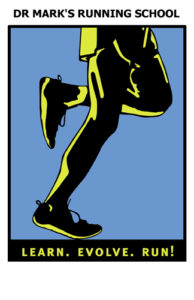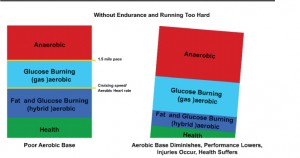“Train Don’t Strain” Arthur Lydiard 1960
 A natural runner is progressively improving their running economy. It is fun to move faster and more comfortable with less effort
A natural runner is progressively improving their running economy. It is fun to move faster and more comfortable with less effort
There is a scene from “The Matrix” where Morpheus shows Neo two pills.
“This is your last chance. After this, there is no turning back. You take the blue pill – the story ends, you wake up in your bed and believe whatever you want to believe. You take the red pill – you stay in Wonderland and I show you how deep the rabbit hole goes.”
For some of you deciding to run slower is like taking the “red pill”. Your choices are taking the blue pill and continue what you are doing, or take the red pill and open your mind to what may be some new magical experience. If you are often sore, injured, or moving much slower than you think you should then go for the red.
For running you need to develop the correct system- the aerobic system. This is the highly efficient system utilizing oxygen, glucose, and fat metabolism to produce energy. The modern analogy is this. Each of us is blessed with a hybrid engine, actually billions of hybrid engines at the muscular level, these are the mighty mitochondria. The electric battery is fat burning – highly efficient with stores to run for days on minimal added fuel. It is resilient to breaking down.
The less efficient but more readily available engine is the gas power or sugars. We are constantly mixing and we always need some gas in the tank. The proportions of electric and gas shift as the effort and heart rate go up. The harder and faster the more gas and less electric.
Let’s now differentiate aerobic vs. anaerobic and the differences with each system. Both Produce ATP allowing muscle contraction bit there are critical important differences.
Most understand the anaerobic because we feel it.
- Explosive exercising (sprinting) with pure anaerobic respiration produces 6 to 10 seconds of immediate energy with ATP and Creatine Phosphate stored in the fast twitch power muscles. No oxygen is needed, but contractions stop after 10 seconds.
- If you lower the pace to a hard effort you can sustain for only 1 to 15 minutes you are still above the anaerobic threshold (AnT). You are demanding ATP faster than the system can produce it aerobically. You use muscle glycogen and lactate as fuel, but the hydrogen ion waste products produce the toxic acidosis. This is not sustainable for longer distances. You produce only 2 ATP per molecule of glucose and lots of nasty stuff which accumulates.
The aerobic (oxygen dependent) system uses the powerful hybrid engines (mitochondria) at the muscular level. Oxygen is delivered to the engines via a rich network of capillaries (blood). Specific enzymes spark the process.
- If you lower the pace below the anaerobic threshold (AnT) (transition from red to light blue in Fig 1) to an oxygen utilizing zone you get 36-38 ATP per molecule of glucose– this is gas/sugar power- and somewhat efficient as a fit person can store enough sugars to give 90 minutes or so of activity.
- Now if you slow down a bit more to below the aerobic threshold (AT) (transition from light blue to dark blue in Fig 1) you can develop the network to break down fat into energy. Your efficiency jumps exponentially-460 ATP per fat molecule! This is electric power. (Endurance Sports Nutrition p 32). If you have ever driven a Prius, you see the subtle mixing of gas and electric which you cannot detect as the driver. Your body is doing this all the time in exercise. You want more efficiency…more electric! Any activity lasting more than a couple hours is largely electric.
Fig 1
1.5 Mile pace = Anaerobic Threshold (AnT)
Cruising Speed = True Aerobic Threshold (AT)
Fig 2
Many of us are running too hard daily and constantly using and replenishing the easily accessed sugar stores. When sugar levels drop or we create acidic waste anaerobically we crash. Mind and body sense an overwhelming fatigue. Topping off this tank with more sugar at high levels of exertion is problematic. Blood is being shunted from the gut to the active muscles. Even if you do force down calories it tends to sit in the gut, or worse you toss it back up. When this occurs you have options. Walk, try to recover, and refill your tank a bit. Or take the more comfortable option and call it a day.
Even worse is when unfit athletes who have not built the aerobic system shift quickly into anaerobic mode as they cannot deliver oxygen to the system. In essence they have few roads (capillaries) and few aerobic engines (mitochondria).
To constantly access the deep fat burning tank you must train correctly and eat correctly. Some added glucose is still important, but we are most efficient in hybrid mode with the majority of the power coming off electric (fat burning).
So how do you build the mitochondria in your muscles, more aerobic enzymes, and more capillaries so your hybrid engines are at optimum performance? Your goal is to build a bigger engine– build billions of mitochondrial factories and the capillary blood supply to deliver the oxygen to them. The heart and lungs are the fuel pump, the engines are the billions of fat and glucose burning mitochondria in the muscles.
The good news is that it is all about running easy. For most highly motivated exercisers, the definition of easy is not uniform. What level of effort is easy to build and utilize the aerobic system? How can you assess this yourself?
The pioneer was New Zealand’s Arthur Lydiard who trained the best middle distance and distance runners in the 1960’s. His system is based on months of aerobic training followed by measured increases in intensity as events approach. His principles still apply in almost all modern training. Lydiard’s runners were taught what easy was under the master’s eye. 800 meter specialists were running 22 mile long runs and 100 mile weeks in their base phase. Why? To build a massive and resilient aerobic system, on which everything else later would be built upon.
Most of us do not have a master teacher, so how do we learn this pace? The secret is a heart rate monitor. The modern masters of this technique are 6 time Ironman Champ Mark Allen, and British Marathon Legend Priscilla Welch. (note Lance Armstrong used these methods too but I have moved his story to the fiction section)
Lydiard’s runners always started their build part of the pyramid with lots of easy aerobic runs, mostly in happy fat burning zone. This aerobic threshold is the fine and mostly undetectable line where you are converting from more efficient fat energy to the more accessible glucose energy. The former has limitless supply, the latter good for about 1-2 hours. Paradoxically, training these fat burning engines produces the rich capillary pathways that allow glucose to be used more efficiently too when it is needed during faster running.
As the training pyramid progressed toward a season, harder aerobic runs closer to the AnT were performed. The runners now had the “aerobic capacity” to perform these. They did not eat before or during the longer runs, and through this method and glycogen depleting much of the slow twitch fibers, the runners began capillarizing and building factories in the fast twitch aerobic fibers. Essentially doing speedwork without the toxic by-products, and further increasing the aerobic capacity. On the nutrition side, they did fill the tanks heartily after these endurance efforts with real New Zealand farm food.
With 6 weeks before the key races , it was time to enhance the anaerobic system required for tolerating oxygen debt and acidity in events which were performed at efforts above the AnT. We have a limited capacity to endure this debt. With huge aerobic capacity, Lydiard’s runners were able to run at faster speeds for longer durations without accumulating acidity and oxygen debt and thus accelerated form the field at the bell lap
Another master of this is Mark Allen. He describes his evolution to this method in this article. Mark tried to finish each and every run all out. After seasons of inconsistencies and fatigue, he soon discovered that running harder and harder was not the answer. Skeptical but curious about Phil Maffetone’s lower effort training he put a heart rate monitor on and at a pace of 8:15 per mile his HR monitor would beep at the preset 155. This was slower than he ever ran. Convinced to take the slow burn approach he took months and ran at 155 HR. During these months he became more efficient and faster at the low heart rate and before his epic victory over Dave Scott in the 1989 Ironman he was running effortless 5:30 miles at this easy effort.
Mark Allen went on to win 6 straight Ironman titles. But what Mark relays to his audiences is that before embracing these methods he lost six straight Ironmans to Dave Scott. In 1989 he not only beat Dave Scott, he beat him on his best day and won by 58 seconds taking 18 minutes off the Ironman record.
Priscilla Welch won the 1987 New York Marathon at age 40, a feat likely never to be repeated. She took up running as recreation in her 30’s. Priscilla was a master of efficiency, with 10k times only a trace faster than her marathon speed. She mastered the MAF test
Priscilla was a believer of the powerful feedback of the Heart Rate monitor. In her build up for races she did the bulk of her training below HR 150. She would not exceed this even if it meant walking up a hill. She would judge her fitness not by a “time trial” (all out effort over a distance) but by the Maximal Aerobic Function Test. Her HR was set to go no higher than 150 and she would measure her time over a 5 mile course. She knew she was aerobically fit when she would hit her goal times at the easy effort.
These experienced athletes and coaches also understood that mixing in hard anaerobic work during the aerobic building phase inhibited aerobic development. Many athletes are constantly doing cycles of high intensity intervals week in week out all year and find themselves fatigued, injured, or lacking the joy in their life and activity. Aerobic running is the happy zone, where the runner’s high exists. Very short 6-10 second sprints can be done all year to develop biomechanical efficiency and improve movement patterns. These short bouts do not produce the damaging acidosis.
For a great series of reads go to the Maffetone Top 10 and see where your deficiencies are. Then adjust and optimize your endurance and fat burning capacity.




To stay at my aerobic HR I have to slow to a crawl or walk up most hills. How to I prepare for races with hilly terrain if I’m always walking up hills? That’s always my concern as I’m walking up hills, that I won’t be ready for a hilly course.
Mike in training slow down, do not fear this…this is a slow and patient process. race day you can go for it a bit.